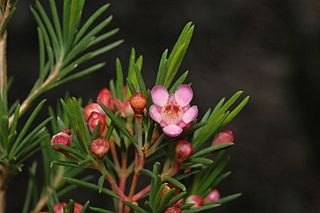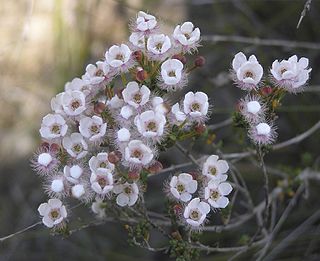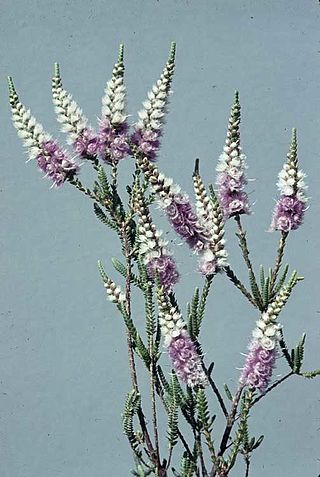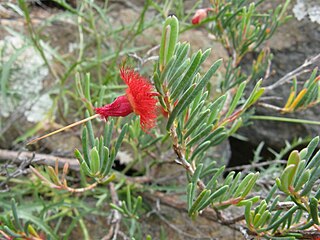
Verticordia plumosa, commonly known as plumed featherflower, is a flowering plant in the myrtle family, Myrtaceae and is endemic to the south-west of Western Australia. It was the first species in the genus to be described, although initially given the name Chamelaucium plumosum. It is a shrub with linear leaves and rounded groups of scented pink, mauve or white flowers. Two varieties of this species have been declared as being "threatened".

Verticordia apecta, commonly known as scruffy verticordia or Hay River featherflower, is a flowering plant in the myrtle family, Myrtaceae and is endemic to the south-west of Western Australia. It is a slender shrub with linear lower stem leaves, narrow elliptic upper stem leaves and elliptic to egg-shaped leaves near the flowers. There are only a few flowers in the upper leaf axils on relatively long stalks and the sepals are deep pink with fine, white fringes.
Verticordia carinata, commonly known as pea-shaped featherflower or Stirling Range featherflower, is a flowering plant in the myrtle family, Myrtaceae and is endemic to Western Australia. It is an erect, spindly shrub with small, well-spaced leaves and pink and red flowers. It is a rarely seen plant, not known between its description in 1849 and its rediscovery in 1990.
Verticordia crebra, commonly known as Barrens featherflower, crowded featherflower or Twertup featherflower, is a flowering plant in the myrtle family, Myrtaceae and is endemic to the south-west of Western Australia. It is a sprawling shrub with crowded, cylinder-shaped leaves with small, yellow flowers that are almost hidden by the leaves but with a style which extends well beyond the petals. The plant looks superficially like a miniature pine tree.

Verticordia cunninghamii, commonly known as tree featherflower or liandu, is a flowering plant in the myrtle family, Myrtaceae and is endemic to an area in the extreme north of Western Australia and the Northern Territory. It is a spindly shrub or small tree with narrow leaves and cream to white, sweetly scented, feathery flowers.

Verticordia habrantha, commonly known as hidden featherflower, is a flowering plant in the myrtle family, Myrtaceae and is endemic to the south-west of Western Australia. It is a slender shrub with short, leafy side-branches and long flowering stems with rounded heads of mostly white flowers. Its hairy sepals are mostly hidden by the round, unfringed petals, and as a result, the plant looks like shrubs in the genus Chamelaucium, to which it is closely related.
Verticordia harveyi, commonly known as autumn featherflower, is a flowering plant in the myrtle family, Myrtaceae and is endemic to the south-west of Western Australia. It is a slender, spindly shrub with relatively long leaves and small white, pink or magenta-coloured flowers in late summer and autumn.

Verticordia helichrysantha, commonly known as coast featherflower or Barrens featherflower, is a flowering plant in the myrtle family, Myrtaceae and is endemic to the south-west of Western Australia. It is a small, woody, open-branched shrub with crowded, linear leaves and small yellow flowers from May to September.

Verticordia decussata is a flowering plant in the myrtle family, Myrtaceae and is endemic to an area in the north of the Northern Territory. It is an open shrub with a distinctive leaves and leaf arrangement and small spikes of cream to white flowers on the ends of the branches.

Verticordia spicata, commonly known as spiked featherflower, is a flowering plant in the myrtle family, Myrtaceae and is endemic to the south-west of Western Australia. It is usually a dense, bushy shrub with small leaves pressed against the stem and spikes of pink flowers from late spring to early summer.

Verticordia pritzelii, commonly known as Pritzel's featherflower, is a flowering plant in the myrtle family, Myrtaceae and is endemic to the south-west of Western Australia. It is a compact, woody shrub with several main stems, small, linear to club-shaped leaves, and rounded groups of deep pink flowers from late spring to mid-summer.

Verticordia picta, commonly known as painted featherflower or china cups, is a flowering plant in the myrtle family, Myrtaceae and is endemic to the south-west of Western Australia. It is a small to medium sized shrub with pink and cupped flowers that are sweetly scented.

Verticordia grandiflora, commonly known as claw featherflower, clawed featherflower or horned featherflower, is a flowering plant in the myrtle family Myrtaceae, and is endemic to the south-west of Western Australia. It is a small, rigid shrub with many short side-branches, mostly linear leaves and heads of yellow flowers which soon age to reddish but which are among the largest in the genus. It is similar in appearance to several other species of verticordias with which it is often confused.

Verticordia huegelii var. decumbens, commonly known as variegated featherflower, is a flowering plant in the myrtle family, Myrtaceae and is endemic to the south-west of Western Australia. It is an almost prostrate shrub, with creamish-lemon coloured flowers turning pink then red as they age, giving the plant a variegated appearance. It is similar to Verticordia huegelii var. huegelii but has a lignotuber and a lower growth habit.
Verticordia huegelii var. stylosa, commonly known as variegated featherflower, is a flowering plant in the myrtle family, Myrtaceae and is endemic to the south-west of Western Australia. It is a single-stemmed shrub with its growth form depending on its surroundings. It is similar to other varieties of the species but differs in its flower colour and the form of the style and staminodes.

Verticordia mitchelliana, commonly known as rapier featherflower, is a flowering plant in the myrtle family, Myrtaceae and is endemic to the south-west of Western Australia. It is a shrub with bright red, rapier-like flowers in spring and early summer, which readily distinguish it from other species. It is commonly grown in private gardens and some forms have larger flowers than those usually found in the wild.

Verticordia ovalifolia, commonly known as oval-leaved featherflower, is a flowering plant in the myrtle family, Myrtaceae and is endemic to the south-west of Western Australia. It is an openly branched shrub with egg-shaped leaves and strap-like, feathery petals in spring.

Verticordia oxylepis, commonly known as bonsai featherflower, is a flowering plant in the myrtle family, Myrtaceae and is endemic to the south-west of Western Australia. It is a small shrub, often with a layered appearance, small leaves and very small yellow and pink flowers.
Verticordia pityrhops, commonly known as East Mount Barren featherflower or pine-like featherflower, is a flowering plant in the myrtle family, Myrtaceae and is endemic to the south-west of Western Australia. It is a single-stemmed shrub which is densely-branched with crowded narrow linear leaves giving the impression of a miniature pine tree. When it flowers in autumn, the shrub is completely covered with masses of very small, honey-scented, pinkish-purple flowers.

Verticordia roei, commonly known as Roe's featherflower is a flowering plant in the myrtle family, Myrtaceae and is endemic to the south-west of Western Australia. It is a shrub with narrow leaves and is often covered with masses of creamy-white coloured flowers in late spring.















